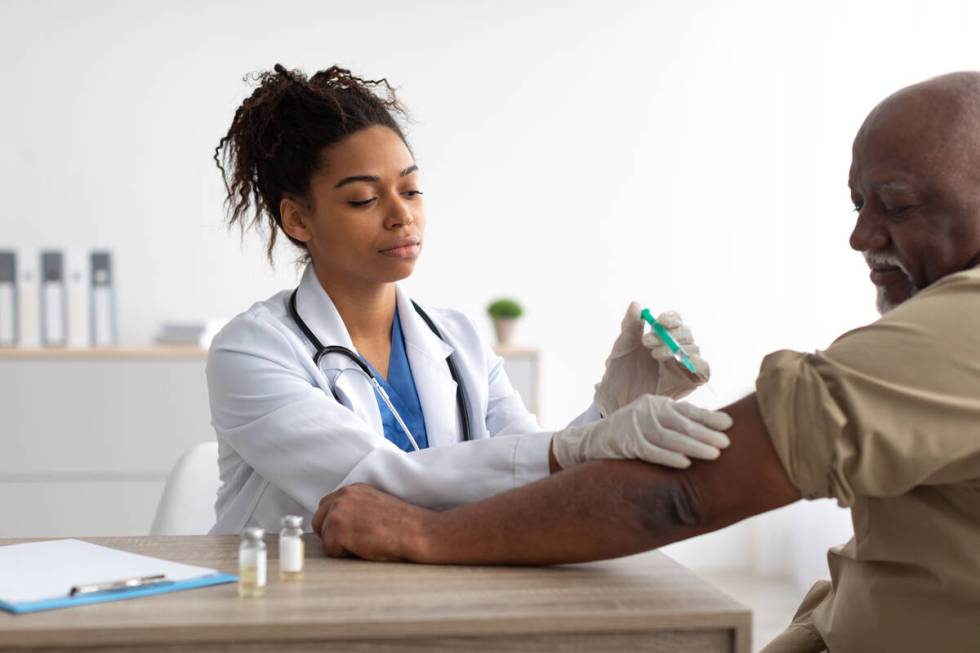Get vaccinated to reduce risk of developing shingles

Question: A friend recently went through a bout of shingles. I really don’t know much about this condition, but I know it was painful. How do you get it? Is there a treatment or vaccine for it?
Answer: Shingles, also known as herpes zoster, is a common condition caused by the varicella-zoster virus, which also causes chickenpox. Not everyone who has had chickenpox will develop shingles. However, after years of lying dormant in nerve tissue near the spinal cord and brain, the virus can reactivate in some people. As it becomes active again, the virus causes pain, tingling and, eventually, a rash of blisters that doesn’t last long.
The reason for shingles is unclear. But it may be due to lowered immunity to infections as you grow older.
Preventing shingles
Vaccines reduce the risk of developing shingles. The Shingrix vaccine is approved and recommended for people 50 and older, including those who have had shingles or previously received the Zostavax vaccine, which is no longer sold in the U.S. Studies suggest that Shingrix protects against shingles for more than five years. The vaccine is given in two doses with two to six months between doses.
Signs and symptoms
Shingles usually affects only a small section on one side of your body and may include:
■ Pain, burning, tingling, itching, numbness or extreme sensitivity to touch
■ Red rash with fluid-filled blisters that begins a few days after the pain and lasts two to three weeks before scabbing over and healing
■ Fever
■ Headache
■ Chills
■ Sensitivity to light
■ General feeling of unease and discomfort
Pain is usually the first symptom of shingles. For some, it can be intense. Depending on the location of the pain, sometimes it can be mistaken for a symptom of problems affecting the heart, lungs or kidneys. Some people experience shingles pain without ever developing the rash.
The shingles rash commonly occurs on one side of the torso. It often appears as a band of blisters that wraps from the middle of the back to the breastbone, following the path of the nerve where the virus has been dormant. However, the rash can occur around one eye, or on the neck or face.
Shingles generally lasts two to six weeks. Most people get shingles only once, but it’s possible to get it two or more times.
See a health care professional as soon as symptoms of shingles appear, especially if:
■ The pain and rash occur near an eye — if left untreated, this infection can lead to permanent eye damage.
■ You’re 60 or older, because age significantly increases the risk of complications.
■ You or someone in your family has a weakened immune system due to cancer, medications, chronic illness or other conditions.
■ The rash is widespread and painful.
When identified early, shingles can be treated with prescription medications to shorten the infection and reduce the risk of complications. Shingles normally isn’t serious, although the rash can cause an eye infection. Another complication, called “postherpetic neuralgia,” causes the skin to remain painful and sensitive to touch for months or years.
A person with shingles can pass the varicella-zoster virus to anyone who isn’t immune to chickenpox. This happens through direct contact with the rash’s open sores. Once infected, the person will develop chickenpox — not shingles.
Because chickenpox can be dangerous for some people, until the shingles blisters scab over, people are contagious and should avoid physical contact with:
■ Anyone with a weak immune system.
■ Newborns.
■ Women who are pregnant.
While shingles cannot be cured, getting vaccinated and seeking prompt treatment with antiviral drugs can speed healing and reduce your risk of complications.
Dr. Jeffery Wheeler practices Family Medicine with the Mayo Clinic Health System in Cannon Falls, Minn.